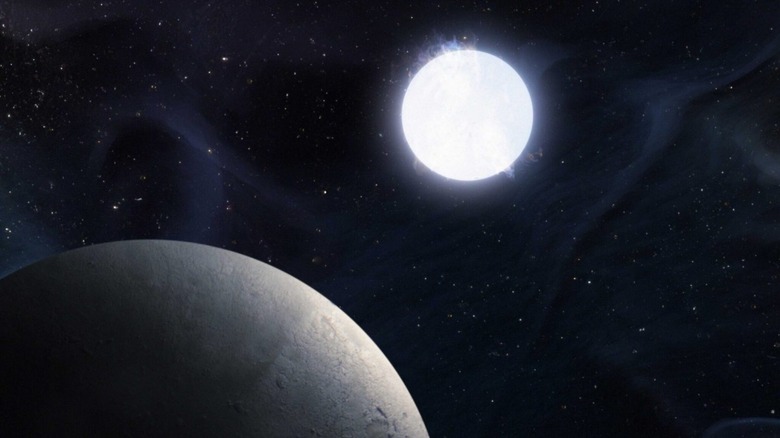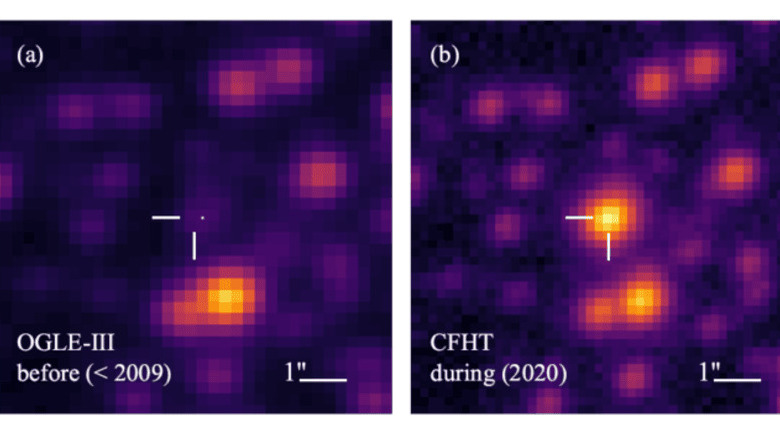This Planet Shows What Earth Might Look Like In 8 Billion Years' Time
The future of the planet may not be the most comfortable of subjects to think about — from the threat of climate change to worry about world wars — but for astronomers, it's something to consider when looking at distant planets outside our solar system, called exoplanets.
Exoplanets can be quite different from Earth, with different sizes, densities, and orbits from their stars. Nevertheless, occasionally researchers find an exoplanet which is similar to Earth and which gives a sneak peak of what the future of our planet could look like.
That happened recently when astronomers discovered a planet located 4,000 light years away which is rocky and has a similar size to Earth. Detailed in Nature Astronomy, the researchers from the University of California, Berkeley, used the W. M. Keck Observatory on Maunakea, Hawaii to study a star system called KMT-2020-BLG-0414, where they found a small star — called a white dwarf — being orbited by an Earth-sized planet at an orbit distance around twice that of the Earth's to the Sun.
What is exciting about this finding is that it could represent what Earth would look like in around eight billion years from now, after the Sun has puffed up to become a red giant and then shrunk down to become a white dwarf — if Earth survives, that is.
"We do not currently have a consensus whether Earth could avoid being engulfed by the red giant Sun in six billion years," said the study's lead author, Keming Zhang. "In any case, planet Earth will only be habitable for around another billion years, at which point Earth's oceans would be vaporized by runaway greenhouse effect — long before the risk of getting swallowed by the red giant."
The future of Earth
So we don't need to worry about Earth being swallowed by the Sun, as the planet will be long past habitable at that point anyway. However, it does raise an interesting question of what the planet could look like billions of years into the future.
The reason that this is uncertain is that it's not clear exactly how big the Sun will puff up to in its red giant phase. When the Sun comes toward the end of its life and its fusion slows down in around five billion years' time, eventually its outer shell will expand and it will grow larger as it cools. Entering its red giant phase, the Sun will almost certainly swallow up Mercury and Venus, though whether or not it will reach Earth is up for debate.
If Earth does manage not to be swallowed, eventually the Sun will shrink back down to form a cool core called a white dwarf. Then, if Earth is still there, it could look like this newly discovered planet.
"Whether life can survive on Earth through that (red giant) period is unknown. But certainly the most important thing is that Earth isn't swallowed by the Sun when it becomes a red giant," said fellow researcher Jessica Lu of UC Berkeley. "This system that Keming's found is an example of a planet — probably an Earth-like planet originally on a similar orbit to Earth — that survived its host star's red giant phase."
With the help of a distant star
Another interesting element about star system KMT-2020-BLG-0414 is how it was discovered using an even more distant star. You might imagine that to study a star, you simply point a telescope at it, and that is indeed how some systems are studied.
However, to look at very distant systems in more detail, astronomers sometimes take advantage of a trick of gravity called gravitational lensing. This natural occurrence happens when something very, very heavy like a star, a galaxy, or even a whole cluster of galaxies has such powerful gravity that it bends spacetime. This creates a magnifying glass-like effect, where if the heavy object passes between us and a distant object, the light from that distant object can be magnified to make the closer object appear bigger and more detailed.
The event KMT-2020-BLG-0414 was detected by the Korea Microlensing Telescope Network, with the lensing star and its potentially future Earth-like planet, located within the Milky Way. This star magnified the light of a more distant background star located 25,000 light-years away, in an event called a microlensing.

